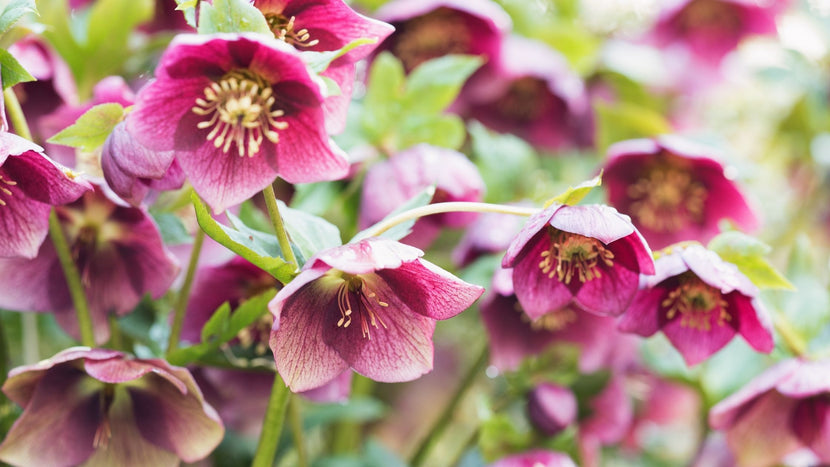How to Plant and Grow Hellebores
Plant Guide

Hellebore plants are Lenten Rose or Christmas Roses because they flower in the mid to late winter into early spring, depending on the varieties. In the past, hellebores have been known as collector plants and were reserved for high-end gardens and landscapes.
Recently hellebores have enjoyed a resurgence in hybridization and are more readily available to gardeners. Breeders have also developed double flowers types, such as Hellebore Confetti Cake, allowing the flowers to stand out even more. You'll find the new varieties easy to grow and tolerant of a wide array of growing conditions.
Ground Rules
Light
All Hellebore types thrive in woodland conditions. They prefer filtered sunlight considered partial shade to full shade—plant hellebore under Japanese maples or in a natural woodland garden. Too much sun tends to "wash out" the leaves, and the color is not as vibrant as those planted in the shade.
Water
Hellebores like evenly moist woodland soils. These soils typically do not stay wet for long periods as the trees will absorb most of the water from rains within a few days. Too much water is the enemy of hellebores, so choose a site where water does not pool or remain for extended periods.
Helleborus foetidus is the best choice for extremely dry soils or if watering is not in your plans. When you plant your new hellebores water them every three days for the first 2 to 3 weeks. After that, begin to reduce the frequency of watering to once per week, eventually providing no additional water except during times of extreme drought.
When watering hellebores, it's essential to water the base of the plant rather than the foliage. If the foliage stays wet for extended periods, the plants can develop leaf spots. Leaf spot causes unsightly dark spots to appear on the leaves, taking away from the beauty of the leaves.
Soil
Hellebores do best in woodland soil, which is high in organic matter. Choose an area with well-draining soil that does not stay wet in the winter. Too much moisture can cause a phenomenon known as "black death" This results from the plant's roots staying too wet, which causes the foliage to turn black.
Food
Hellebores thrive in soils that are alive. Most woodland soils contain colonies of mycorrhizae that are beneficial to the roots of plants growing in them. To add life to your soil, you can use Bio-Tone Starter Fertilizer by Espoma. It is an easy way to bring life to your soil when planting.
Regular fertilization of hellebores is unnecessary if the plants are grown in healthy soil. If you need to fertilize your plants, it is recommended to use an organic fertilizer that is timed release. These types of fertilizer will release just the right amount of nutrients over an extended period rather than all at once like some chemical fertilizers can do. Espoma Plant-Tone is a good choice.
Sprinkle the recommended amount around the base of the plant and water in as directed. This should be done in the early spring and again in the fall. This allows the plant to have the necessary nutrition to flower and stay healthy through the winter.
Planting Process
- Unbox your new hellebore plant and remove the packing. Water the plant and place it in a partially shaded location to acclimate to its new environment for a day or two.
- Dig a hole wider than the pot but not deeper. It is essential with hellebores not to plant the plant too deep. This can cause the base of the plant to rot.
- Place the Hellebore in the hole, making sure the base of the plant is above the level of the existing soil. Backfill the rootball being careful not to leave any voids or air pockets. Mulch the plants with a thin layer of organic mulch.
- Water the plants after planting and after the soil surrounding the plants is dry.
Should I Prune my Helleborus?
Types of Hellebore Plants
| Name: | Flower Color: | Petal Pattern: | Petal Shape: |
|---|---|---|---|
| Spanish Flare | Cream and Purple | Bicolor | Obtuse, round |
| Sandy Shores | Purple and Pink | Speckled, Bicolor | Obtuse, round |
| French Kiss | Purple and White | Bicolor | Obtuse, round |
| Molly's White | White | Solid | Rounded |
| Viv Victoria | Light and Dark Purple | Speckled, Tie-dye | Ruffled, pointed |
| Ivory Prince | Green and maroon | Ombre | Pointed |
| Shooting Star | Pink and Green | Ombre | Rounded |
| Pink Frost | Shades of Pink | Ombre | Rounded |
| Mahogany Snow | Pink and White | Bicolor | Rounded |
| Cinnamon Snow | Pink and Tan | Ombre | Rounded |
| Anna's Red | Reddish-purple | Solid | Rounded |
